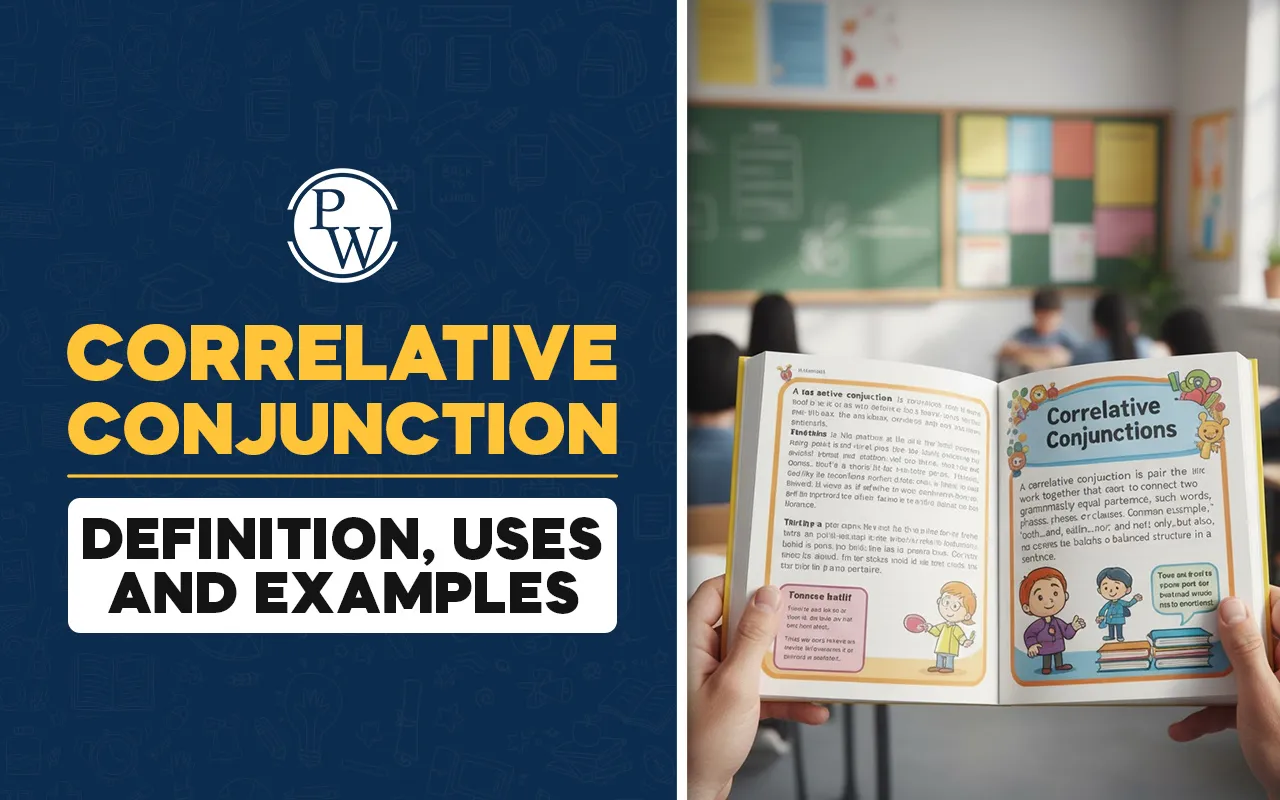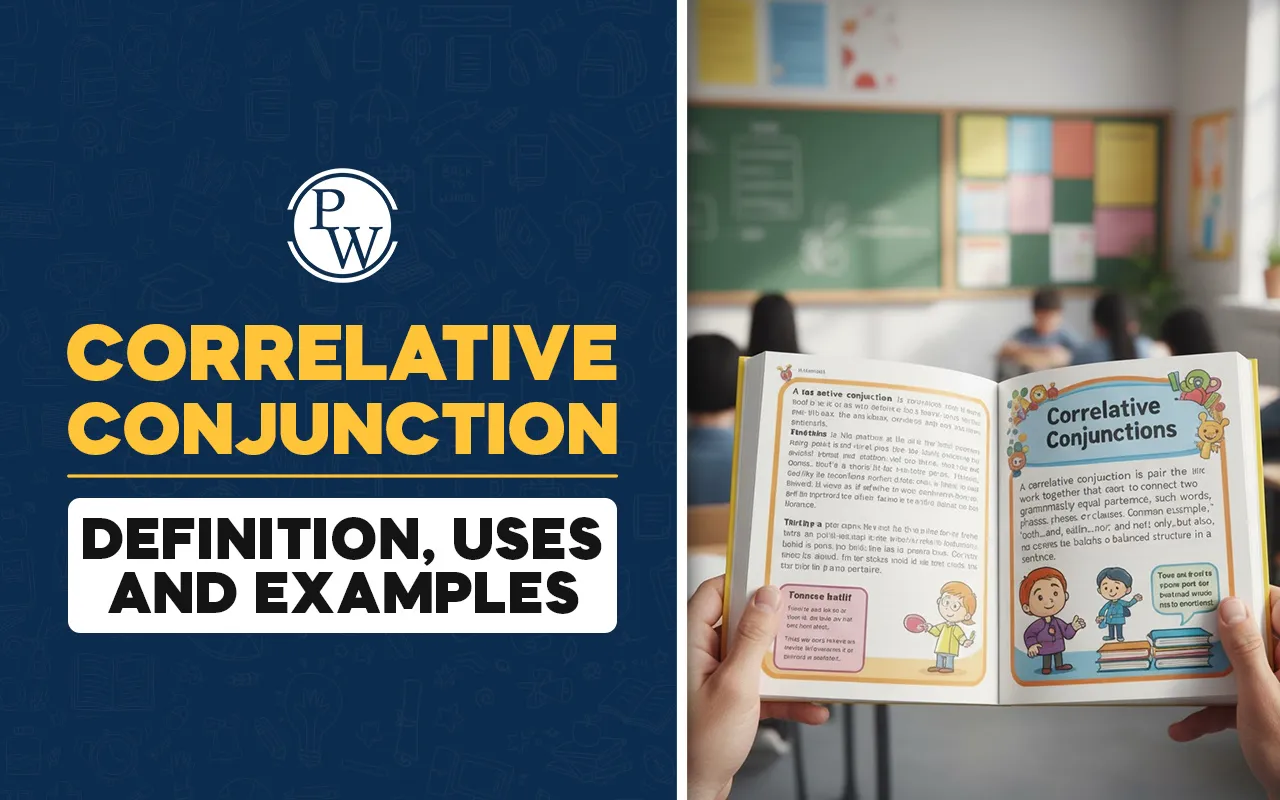

Correlative Conjunction
Correlative conjunctions are an essential part of English grammar because they help connect related ideas in a balanced and meaningful way. Correlative conjunctions always come in pairs, and both words in the pair must be used together to form a complete structure. For example, pairs like either…or, neither…nor, both…and, and not only…but also help link equal grammatical elements such as two nouns, two verbs, two phrases, or even two clauses. These paired words show relationships like choice, contrast, equality, or emphasis.
Learning to use these conjunctions correctly helps improve sentence structure, readability, and overall writing quality. As we explore correlative conjunctions definition, meanings, lists, and examples, you will gain a deeper understanding of how they function and how they can be applied in everyday communication.
What Are Correlative Conjunctions?
Correlative conjunctions are pairs of conjunctions used together to join two equal grammatical elements in a sentence. This means that the ideas, words, or phrases connected must be similar in structure and importance. This balance is what makes correlative conjunctions different from other forms of conjunctions.
Correlative Conjunctions Meaning
The meaning of correlative conjunctions is tied to their purpose:
They show relationships between ideas. These relationships might express:
-
Choice (either…or)
-
Negation (neither…nor)
-
Addition (both…and)
-
Emphasis (not only…but also)
-
Comparison (as…as)
-
Cause and effect (such…that)
-
Alternatives (whether…or)
These pairs ensure that the connected ideas are balanced and clearly understood.
Read More: Coordinating Conjunctions
Uses of Correlative Conjunctions
Correlative conjunctions allow writers and speakers to express relationships between ideas smoothly. These conjunctions add clarity, emphasis, and balance to sentences. Below are the main uses of correlative conjunctions:
1. To Show Alternatives
The pair either…or helps express a choice between two possibilities.
Example: Either we leave now, or we miss the event.
2. To Express Negation
The pair neither…nor is used to deny two options at the same time.
Example: Neither the weather nor the traffic stopped us from going.
3. To Add Emphasis
The pair not only…but also adds emphasis and is often used to express surprise or highlight important information.
Example: Not only did he complete the work early, but he also helped others finish theirs.
4. To Show Inclusion
Both…and shows that two ideas or items are equally included or important.
Example: Both the introduction and the conclusion were well written.
5. To Express Alternatives or Possibilities
The pair whether…or presents two possible situations, outcomes, or opinions.
Example: Whether you agree or disagree, the rule will apply.
6. To Show Comparison
The pair as…as helps compare two things that are equal in degree or quality.
Example: She is as strong as her brother.
7. To Show Cause and Effect
The pair such…that helps explain how one event leads to another.
Example: Such was the noise that no one could concentrate.
8. To Show Immediate Sequence
The pair no sooner…than shows that one action happened immediately after another.
Example: No sooner had he opened the door than the phone rang.
Read More: Idioms and Phrases in English
List of Correlative Conjunctions
Below is a list of the most commonly used correlative conjunctions words. These pairs are essential for clear sentence construction and are widely used in both spoken and written English.
-
either…or – used to show choice
-
neither…nor – used to express negation
-
both…and – used to show addition or inclusion
-
not only…but also – used to add emphasis
-
whether…or – used to present alternatives
-
such…that – used to show cause and effect
-
as…as – used for comparisons
-
no sooner…than – used to show immediate sequence
-
scarcely…when – similar to no sooner…than
-
rather…than – used to express preference
-
just as…so – used to express similarity
-
if…then – used to show a conditional relationship
Read More: Tense Chart
Examples of Sentences Using Correlative Conjunctions
The following are several sentences using correlative conjunctions that demonstrate how these pairs work in real-life contexts. Each example helps reinforce the structure and function of correlative conjunctions.
-
Either you apologize now, or the situation may worsen.
-
Neither the teacher nor the students understood the question.
-
Both the manager and the supervisors supported the new rule.
-
Not only was the speech inspiring, but it also motivated the audience.
-
Whether you work alone or with a group, focus is always important
-
She is as talented as her sister.
-
No sooner had the plane landed than the passengers began to stand.
-
Such was his confidence that he performed without fear.
-
Rather walk slowly than injure yourself by rushing.
-
Scarcely had they finished dinner when the guests arrived.
These examples show how correlative conjunctions help express relationships while maintaining balance between connected ideas.
Also Read: Non Finite Verbs
Correlative Conjunction Examples
The following are more correlative conjunctions examples with short explanations to strengthen understanding:
1. Either…or (Choice)
Example: Either the cat or the dog made that noise.
Shows that one of two possibilities is responsible.
2. Neither…nor (Negation)
Example: Neither the rain nor the heat stopped the match.
Shows both conditions failed to stop the event.
3. Both…and (Inclusion)
Example: Both the book and the movie were meaningful.
Shows the equal importance of two items.
4. Not only…but also (Emphasis)
Example: Not only did he improve the design, but he also reduced the cost.
Adds emphasis by highlighting two impressive actions.
5. Such…that (Cause-effect)
Example: Such was her determination that she achieved every goal.
Shows that determination directly caused success.
6. As…as (Comparison)
Example: The river is as wide as a highway.
Shows similarity in measurement.
7. Whether…or (Alternatives)
Example: Whether you plan to stay or leave, let us know soon.
Presents two possible actions.
Enhance Your Child’s English Skills with CuriousJr
Every parent wants their child to be confident in English and excel at school. CuriousJr makes this possible with interactive Online English Classes that cover grammar, vocabulary, reading, writing, listening, and speaking. Our curriculum is carefully designed in line with the Cambridge English Scale and CEFR standards, ensuring a structured and effective learning experience.
With CuriousJr, children gradually become fluent, overcome hesitation, and gain the confidence to express themselves in exams, schoolwork, and everyday conversations. Guided by dedicated mentors, learning is enjoyable, engaging, and motivating. Parents can also easily track their child’s progress in both academics and communication skills.
Enroll today and give your child the opportunity to improve their English through CuriousJr’s fun, interactive classes, specially designed for young learners.
